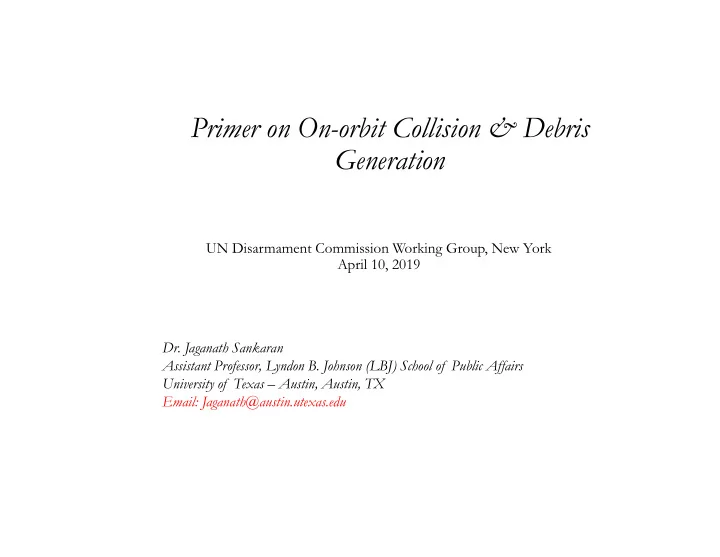

Primer on On-orbit Collision & Debris Generation UN Disarmament Commission Working Group, New York April 10, 2019 Dr. Jaganath Sankaran Assistant Professor, Lyndon B. Johnson (LBJ) School of Public Affairs University of Texas – Austin, Austin, TX Email: Jaganath@austin.utexas.edu
Outline of Presentation ISSUE 3 ISSUE 2 ISSUE 1 ARE THE CALCULATED HOW “PROBABLE” IS WHAT HAPPENS “PROBABILIES” IT FOR TWO THINGS WHEN TWO THINGS USEFUL? TO GO BOOM IN GO BOOM IN SPACE? SPACE? 2
On-orbit collisions (Accidental, Hypervelocity/Catastrophic, and Recorded) Impact date: 23 December 1991 Impact date:24 July 1996 Impact date: 17 January 2005 Impact date: 10 February 2009 Object 1: Cosmos 1934 Object 1: Cerise (spacecraft) Object 1: Thor Burner 2A Object 1: Cosmos 2251 Object 2: Cataloged debris 13475 Object 2: Cataloged debris 18208 Object 2: Cataloged debris 26207 Object 2: Iridium 33 Altitude: 980km Altitude: 685km Altitude: 885km Altitude: 789km New cataloged New cataloged New cataloged New cataloged debris generated: 2 debris generated: 1 debris generated: 6 debris generated: 2199 Impact velocity: 14.3km/s Impact velocity: 14.8km/s Impact velocity: 5.7km/s Impact velocity: 11.6km/s Energy-to-mass ratio: 7.66104 Energy-to-mass ratio: 8.30106 Energy-to-mass ratio: 6.28105 Energy-to-mass ratio: 1.59107 J/kg J/kg J/kg J/kg
Inferences • Debris-Intact collisions are more probable • All collisions are not created equal • We don’t know why • How objects collide may be as important as which objects collide • We are “good” at answering which objects will collide. But, we are “not so good” at answering how objects collide. How objects collide has a direct bearing on debris produced.
ISSUE 3 ISSUE 2 ISSUE 1 ARE THE HOW “PROBABLE” IS WHAT HAPPENS “PROBABILIES” IT FOR TWO THINGS WHEN TWO THINGS USEFUL? TO GO BOOM IN GO BOOM IN SPACE? SPACE? 5
Assumptions in the Estimate Empirical Systemic Collision Probability in LEO • Number of unclassified and classified objects in LEO space • Orbital density of objects in 10 altitude shells each 200 km wide (up to 2,000 km). Average fluxes in each altitude shell is determined • Average Collision Rate of three possible combinations in each altitude shell is determined. Total collision rates is obtained by summing up all the shell contributions • Debris-Debris, Debris-Intact, and Intact-Intact collisions • Probability of “ k” collisions in a given time period (in 2,000 km orbital region)
Probability of k collisions in LEO (Debris-Debris, Debris-Intact, and Intact-Intact collisions) All collision probabilities are calculated beginning mid-2013. Probability of exactly 4 collision by 2030 = 18.7% Probability of 1 to 4 collision by 2030 = 50%
ISSUE 3 ISSUE 2 ISSUE 1 ARE THE HOW “PROBABLE” IS WHAT HAPPENS “PROBABILIES” IT FOR TWO THINGS WHEN TWO THINGS USEFUL? TO GO BOOM IN GO BOOM IN SPACE? SPACE? 8
Are the “probabilities” useful? • The probabilities determined in the previous slides are a “bird’s eye” view. They are purely empirical and not based on computationally intensive orbital modeling and simulation • They provide one probability number to describe the chance that any randomly selected object (debris or intact) that lies within 2,000 km from earth will collide with any other object in the same region of space • While providing a broad picture of the nature of the existing orbital pollution, the number has limitations • They are not very helpful for satellite operators worrying about a particular satellite in a specific orbit
10 February 2009: Iridium 33-Cosmos 2251 Collision Too Many Collision Warnings?
10 February 2009: Iridium 33-Cosmos 2251 Collision IRIDIUM 33 COSMOS 2251
Inferences • System level probabilities provide very little guidance for individual satellite operators • Conjunction Analysis determines collision probabilities of a specific orbital object. More accurate but computationally time consuming • Conjunction Analysis suffers limitations • Improvements have been slow and evolutionary
Thank you.
Recommend
More recommend